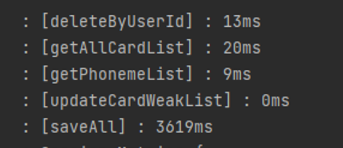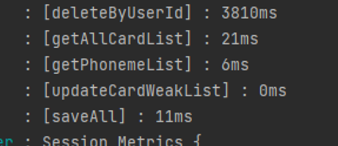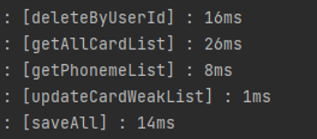📍 기존 코드와 문제점
1. 문제 상황
사용자가 학습하는 전체 리스트를 업데이트 해줘야하는데 이 때 대략 통신이 5초이상 걸린다는 것을 알게됐다.
2. 현재 코드 흐름
public String updateCardWeakSound(Long userId){
//card weaksound 테이블 해당 userId 행 전부 삭제
cardWeakSoundRepository.deleteByUserId(userId);
List<Card> cardList = getCardListWithoutSentence();
List<Long> phonemeList = getPhonemeList(userId);
cardList.forEach(card -> {
List<Long> phonemes = card.getPhonemesMap();
if(!Collections.disjoint(phonemes, phonemeList)){
cardWeakSoundRepository.save(new CardWeakSound(userId ,card.getId()));
}
});
return "카드 취약음 갱신 성공";
}
protected List<Card> getCardListWithoutSentence(){
List<Card> cardList = new ArrayList<>();
for(int i = 5; i <= 31; i++){
cardList.addAll(cardRepository.findAllByCategoryId(Long.valueOf(i)));
}
return cardList;
}
protected List<Long> getPhonemeList(Long userId){
List<UserWeakSound> userWeakSoundList = userWeakSoundRepository.findAllByUserId(userId);
List<Long> phonemeList = new ArrayList<>();
userWeakSoundList.forEach(userWeakSound -> {
phonemeList.add(userWeakSound.getUserPhoneme());
});
return phonemeList;
}
1. updateCardWeakSound가 호출
2. [deleteByUserId] : card_weaksound table에서 userId에 해당하는 행을 전부 삭제
3. [getCardListWithoutSentence] : card table에서 cardList를 불러옴
4. [getPhonemeList] : user_weaksound table에서 userId에 해당하는 userWeakSound List를 가져온다
5. [updateCardWeakList] : card_weaksound table에 조건이 맞으면 insert한다
모두 총 4번 DB와 통신한다.
3. 시간 측정

요청 시 응답까지 총 시간
Postman으로 측정해 보았을 때 평균적으로 5초 ~ 6초 정도 소요됐다.

각 DB와 통신할 때마다 걸린 시간
getCardListWithoutSentence와 updateCardWeakList에서 많은 시간을 사용하는 것을 볼 수 있다.
4. 결론
getCardListWithoutSentence와 updateCardWeakList에서 개선이 필요하다.
📍 getCardListWithoutSentence 해결
1. 현재 코드
protected List<Card> getCardListWithoutSentence(){
List<Card> cardList = new ArrayList<>();
for(int i = 5; i <= 31; i++){
cardList.addAll(cardRepository.findAllByCategoryId(Long.valueOf(i)));
}
return cardList;
}
categoryId마다 card table에 요청을 보내고 있다.
즉 거의 30번 select 요청을 하는 것이다
2. 해결 방안
DB에 한번의 요청으로 내가 원하는 값을 받아 올 수 있도록 IN을 사용했다.
IN : SELECT * FROM employee WHERE id IN (1,2,3...)
2. 변경 된 코드
service 코드
protected List<Card> getCardListWithoutSentence(){
List<Long> categoryIds = Arrays.asList(
5L, 6L, 7L, 8L, 9L, 10L, 11L, 12L, 13L,
14L, 15L, 16L, 17L, 18L, 19L, 20L, 21L, 22L,
23L, 24L, 25L, 26L, 27L, 28L, 29L, 30L, 31L
);
List<Card> cardList = cardRepository.findByCategoryIdIn(categoryIds);
return cardList;
}
repository에 추가한 코드
List<Card> findByCategoryIdIn(List<Long> categoryIds);
요청을 딱 한번만 보내고 내가 원하는 cardList를 받아올 수 있다
4. 시간

⏰ 285ms → 21ms 으로 개선된 것을 볼 수 있다.
📍updateCardWeakList 해결
1. 기존코드
cardList.forEach(card -> {
List<Long> phonemes = card.getPhonemesMap();
if(!Collections.disjoint(phonemes, phonemeList)){
cardWeakSoundRepository.save(new CardWeakSound(userId ,card.getId()));
}
});
매번 save를 보내는 걸 볼 수 있다.
한번에 몇백개씩 요청을 보내므로 여기서 시간이 가장 많이 소요된다.
시도해 본 해결 방법
- jpa의 saveAll
- jpa의 batch insert
- jdbc의 bulkUpdate
2. JPA의 saveAll
saveAll은 save와 다르게 1개의 Trasaction으로 save()를 여러번 호출한다.
save를 여러번 호출하는 것을 동일하다.
변경 된 코드
public String updateCardWeakSound(Long userId){
//card weaksound 테이블 해당 userId 행 전부 삭제
cardWeakSoundRepository.deleteByUserId(userId);
List<Card> cardList = getCardListWithoutSentence();
List<Long> phonemeList = getPhonemeList(userId);
List<CardWeakSound> cardWeakSoundList = new ArrayList<>();
cardList.forEach(card -> {
List<Long> phonemes = card.getPhonemesMap();
if(!Collections.disjoint(phonemes, phonemeList)){
cardWeakSoundList.add(new CardWeakSound(userId ,card.getId()));
}
});
cardWeakSoundRepository.saveAll(cardWeakSoundList);
return "카드 취약음 갱신 성공";
}
saveAll 을 사용해도 실행시간에 큰 차이가 있지 않았다.
실행시간

⏰ saveAll에서 여전히 3초 이상 소요되는 모습
3. Jpa의 batchInsert
bulkInsert란 ?
insert를 각각 보내는 것이 아니라 위의 예시처럼 한개의 쿼리로 여러 insert 요청을 한방에 보내는 것
insert into table (attribute1, attribute2) values
(1, 2),
(1, 2),
(1, 2),
(1, 2)
단건으로 요청을 너무 많이 보내는 게 시간의 원인이라고 생각하여 한번에 삽입하는 bulk insert를 사용하고자 했으나
jpa + mysql은 id 생성을 @GeneratedValue(strategy = GenerationType.IDENTITY)을 사용하기 때문에
insert을 해야 id를 알 수 있으므로 jpa의 batch insert는 사용할 수 없다
batch insert는 반드시 삽입 전에 id를 알아야하기 때문
4. JDBC의 batchUpdate
Jdbc template에서 사용하는 batchUpdate사용하여 bulk Insert를 해보자
application.properties에 ?rewriteBatchedStatements=true를 추가해줘야한다
spring.datasource.url=jdbc:mysql://{URL}/test?rewriteBatchedStatements=true
변경 후 코드
jdbcTemplate 을 이용한 repository
@Repository
@Slf4j
@RequiredArgsConstructor
public class BulkRepository {
private final JdbcTemplate jdbcTemplate;
@PersistenceContext
private EntityManager em;
public void saveAll(List<CardWeakSound> cardWeakSoundList){
String sql = "INSERT INTO card_weaksound (user_id, card_id) VALUES (?, ?)";
jdbcTemplate.batchUpdate(sql,
cardWeakSoundList,
cardWeakSoundList.size(),
(PreparedStatement ps, CardWeakSound cardWeakSound) -> {
ps.setLong(1, cardWeakSound.getUserId());
ps.setLong(2, cardWeakSound.getCardId());
});
em.clear();
}
}
시간

⏰ 3434ms -> 11ms로 매우 시간이 줄었다.
그런데 이 때 delete하는 부분의 시간이 매우 증가했다.
영속성 문제인 듯하다..(확실하지않음)
계속 찾아보고 공부해봤는데 아직 명확한 이유는 모르겠다
그래서 delete까지 jdbc를 이용해서 진행하였다.
@Repository
@Slf4j
@RequiredArgsConstructor
public class BulkRepository {
private final JdbcTemplate jdbcTemplate;
public void deleteAllByUserId(Long userId){
String sql = "DELETE FROM card_weaksound WHERE user_id = ?";
int count = jdbcTemplate.update(sql, userId);
log.info("[Delete] : " + count);
}
}
추가로 jdbc로 넣었을 때 영속성을 초기화 해주는 코드도 추가하였다.
@Repository
@Slf4j
@RequiredArgsConstructor
public class BulkRepository {
private final JdbcTemplate jdbcTemplate;
@PersistenceContext
private EntityManager em;
public void saveAll(List<CardWeakSound> cardWeakSoundList){
String sql = "INSERT INTO card_weaksound (user_id, card_id) VALUES (?, ?)";
jdbcTemplate.batchUpdate(sql,
cardWeakSoundList,
cardWeakSoundList.size(),
(PreparedStatement ps, CardWeakSound cardWeakSound) -> {
ps.setLong(1, cardWeakSound.getUserId());
ps.setLong(2, cardWeakSound.getCardId());
});
//영속성 초기화
em.clear();
}
public void deleteAllByUserId(Long userId){
String sql = "DELETE FROM card_weaksound WHERE user_id = ?";
jdbcTemplate.update(sql, userId);
}
}
📍 변경 후 시간

각 DB와 통신할 때마다 걸린 시간
실행 시간이 모두 매우 감소한 것을 볼 수 있다.

요청 시 응답까지 총 시간
⏰ 5000ms -> 141ms로 감소하였다.
📍 요약
전체 코드
service 코드
@Service
@RequiredArgsConstructor
@Slf4j
public class CardWeakSoundService {
private final BulkRepository bulkRepository;
private final CardRepository cardRepository;
private final UserWeakSoundRepository userWeakSoundRepository;
/**
* 취약음 갱신 시 user weaksound table update
* @param userId
* @return
*/
@Transactional
public String updateCardWeakSound(Long userId){
//card weaksound 테이블 해당 userId 행 전부 삭제
bulkRepository.deleteAllByUserId(userId);
List<Card> cardList = getCardListWithoutSentence();
List<Long> phonemeList = getPhonemeList(userId);
List<CardWeakSound> cardWeakSoundList = new ArrayList<>();
cardList.forEach(card -> {
List<Long> phonemes = card.getPhonemesMap();
if(!Collections.disjoint(phonemes, phonemeList)){
cardWeakSoundList.add(new CardWeakSound(userId ,card.getId()));
}
});
bulkRepository.saveAll(cardWeakSoundList);
return "카드 취약음 갱신 성공";
}
protected List<Card> getCardListWithoutSentence(){
List<Long> categoryIds = Arrays.asList(
5L, 6L, 7L, 8L, 9L, 10L, 11L, 12L, 13L,
14L, 15L, 16L, 17L, 18L, 19L, 20L, 21L, 22L,
23L, 24L, 25L, 26L, 27L, 28L, 29L, 30L, 31L
);
List<Card> cardList = cardRepository.findByCategoryIdIn(categoryIds);
return cardList;
}
protected List<Long> getPhonemeList(Long userId){
List<UserWeakSound> userWeakSoundList = userWeakSoundRepository.findAllByUserId(userId);
List<Long> phonemeList = new ArrayList<>();
userWeakSoundList.forEach(userWeakSound -> {
phonemeList.add(userWeakSound.getUserPhoneme());
});
return phonemeList;
}
}
repository 코드
@Repository
@Slf4j
@RequiredArgsConstructor
public class BulkRepository {
private final JdbcTemplate jdbcTemplate;
@PersistenceContext
private EntityManager em;
public void saveAll(List<CardWeakSound> cardWeakSoundList){
String sql = "INSERT INTO card_weaksound (user_id, card_id) VALUES (?, ?)";
jdbcTemplate.batchUpdate(sql,
cardWeakSoundList,
cardWeakSoundList.size(),
(PreparedStatement ps, CardWeakSound cardWeakSound) -> {
ps.setLong(1, cardWeakSound.getUserId());
ps.setLong(2, cardWeakSound.getCardId());
});
em.clear();
}
public void deleteAllByUserId(Long userId){
String sql = "DELETE FROM card_weaksound WHERE user_id = ?";
jdbcTemplate.update(sql, userId);
}
}
1. 여러 개를 검색해서 하나의 리스트를 받고자 할 때는 findByIn을 사용하면 좋다 (단 검색할 In이 너무 많아도 효율이 떨어짐)
2. mysql + jpa를 사용하면 jpa의 batch insert를 사용할 수 없으므로 (@id generate 방식을 바꾸지 않는 이상) jdbc의 batchUpdate를 사용하면 bulkInsert를 할 수 있다. 이 때 영속성 문제를 유의해두어야함
📍 느낀점
통신을 너무 많이하는 게 항상 시간을 많이 소요하는 것 같다.
그래도 항상 찾아보면 개선할 방법이 있는게 개발의 즐거운 점인 것 중 하나인 것 같다.
'Programming > Spring' 카테고리의 다른 글
| [JPA] Entity에서 사용되는 Annotation 정리 (@Table, @Entity, @Column, @Enumerated, @Temporal .. ) (2) | 2025.05.26 |
|---|---|
| [스프링] DTO에 @NoArgsConstructor와 @Gettter이 필요한 이유 (3) | 2024.07.30 |
| [스프링] [에러해결] 모든 http response의 한글 깨짐을 한방에 해결하기 (3) | 2024.04.30 |
| [스프링] @RestControllerAdvice 리팩토링 (2) | 2024.04.14 |
| [스프링] WAS WebApplicationServer란? (3) | 2024.04.10 |

